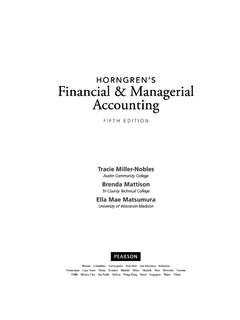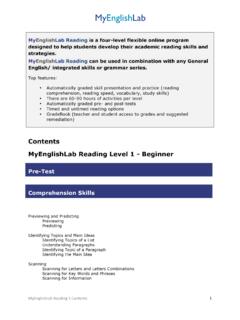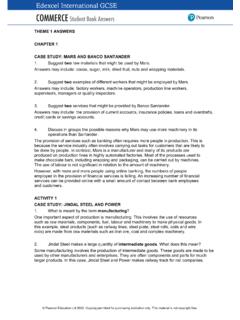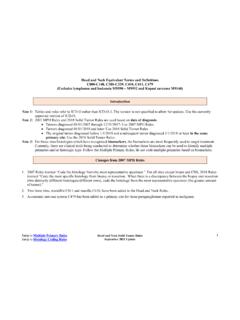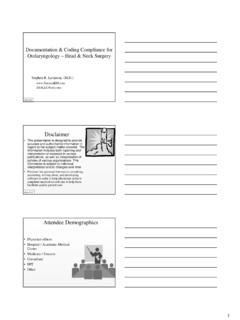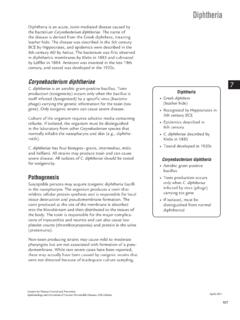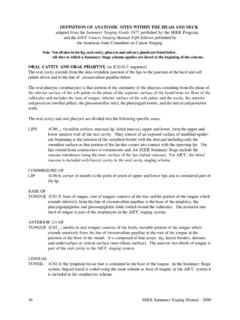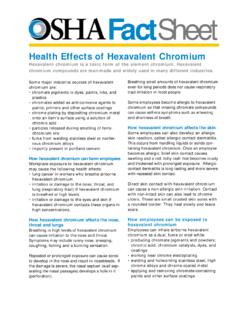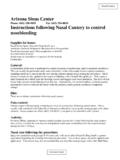Transcription of EXERCISE 9 The Axial Skeleton - Pearson
1 EXERCISE . 9 The Axial Skeleton Objectives Name the three parts of the Axial Skeleton . Identify the bones of the Axial Skeleton , either by examining isolated bones or by pointing them out on an articulated Skeleton or skull, and name the important bone markings on each. Name and describe the different types of vertebrae. Discuss the importance of intervertebral discs and spinal curvatures. Identify three abnormal spinal curvatures. List the components of the thoracic cage. Identify the bones of the fetal skull by examining an articulated skull or image. Define fontanelle, and discuss the function and fate of fontanelles. Discuss important differences between the fetal and adult skulls. Materials Pre-Lab Quiz Intact skull and Beauchene skull 1. The Axial Skeleton can be divided into the skull, the vertebral column, X-ray images of individuals with scoliosis, and the: lordosis, and kyphosis (if available) a. thoracic cage c.
2 Hip bones Articulated Skeleton , articulated vertebral b. femur d. humerus column, removable intervertebral discs 2. Eight bones make up the , which encloses and protects the Isolated cervical, thoracic, and lumbar brain. vertebrae, sacrum, and coccyx a. cranium b. face c. skull Isolated fetal skull 3. How many bones of the skull are considered facial bones? 4. Circle the correct underlined term. The lower jawbone, or maxilla /. mandible, articulates with the temporal bones in the only freely movable joints in the skull. 5. Circle the correct underlined term. The body / spinous process of a typical vertebra forms the rounded, central portion that faces anteriorly in the human vertebral column. 6. The seven bones of the neck are called vertebrae. a. cervical b. lumbar c. spinal d. thoracic 7. The vertebrae articulate with the corresponding ribs. a. cervical b. lumbar c. spinal d. thoracic 8. The , commonly referred to as the breastbone, is a flat bone formed by the fusion of three bones: the manubrium, the body, and the xiphoid process.
3 A. coccyx b. sacrum c. sternum 9. Circle True or False. The first seven pairs of ribs are called floating ribs For related EXERCISE study tools, go to the because they have only indirect cartilage attachments to the sternum. Study Area of MasteringA&P. There you 10. A fontanelle: will nd: a. is found only in the fetal skull Practice Anatomy A&PFlix b. is a fibrous membrane Lab c. allows for compression of the skull during birth Practice quizzes, d. all of the above PhysioEx Histology Atlas, eText, Videos, and more! 121. 122 EXERCISE 9. T. he Axial Skeleton (the green portion of Figure on Skeleton forms the longitudinal axis of the body and protects p. 108) can be divided into three parts: the skull, the ver- the brain, spinal cord, heart, and lungs. tebral column, and the thoracic cage. This division of the The Skull The skull is composed of two sets of bones. Those of the cra- nium (8 bones) enclose and protect the fragile brain tissue.
4 Read through this material, identify each bone on an in- The facial bones (14 bones) support the eyes and position tact and/or Beauchene skull (see Figure ). them anteriorly. They also provide attachment sites for facial Note: Important bone markings are listed in the tables for muscles. All but one of the bones of the skull are joined by the bones on which they appear, and each bone name is interlocking fibrous joints called sutures. The mandible is colored to correspond to the bone color in the figures. attached to the rest of the skull by a freely movable joint. Activity 1 The Cranium The cranium may be divided into two major areas for study . Identifying the Bones of the Skull the cranial vault, or calvaria, forming the superior, lateral, The bones of the skull (Figures , pp. 123 131) and posterior walls of the skull; and the cranial base, forming 9 are described in Tables and on p. 128. As you (Text continues on page 128.)
5 Table The Axial Skeleton : Cranial Bones and Important Bone Markings Cranial bone Important markings Description Frontal (1) N/A Forms the forehead, superior part of the orbit, and the floor of the anterior Figures , , , cranial fossa. , and Supraorbital margin Thick margin of the eye socket that lies beneath the eyebrows. Supraorbital foramen (notch) Opening above each orbit allowing blood vessels and nerves to pass. Glabella Smooth area between the eyes. Parietal (2) N/A Form the superior and lateral aspects of the skull. Figures , , , , and Temporal (2) N/A Form the inferolateral aspects of the skull and contribute to the middle cranial Figures , , , fossa; each has squamous, tympanic, and petrous parts. , , and Squamous part Located inferior to the squamous suture. The next two markings are located in this part. Zygomatic process A bridgelike projection that articulates with the zygomatic bone to form the zygomatic arch.
6 Mandibular fossa Located on the inferior surface of the zygomatic process; receives the condylar process of the mandible to form the temporomandibular joint. Tympanic part Surrounds the external ear opening. The next two markings are located in this part. External acoustic meatus Canal leading to the middle ear and eardrum. Styloid process Needlelike projection that serves as an attachment point for ligaments and muscles of the neck. (This process is often missing from demonstration skulls because it has broken off.). Petrous part Forms a bony wedge between the sphenoid and occipital bones and contributes to the cranial base. The remaining temporal markings are located in this part. Jugular foramen Located where the petrous part of the temporal bone joins the occipital bone. Forms an opening which the internal jugular vein and cranial nerves IX, X, and XI pass. Carotid canal Opening through which the internal carotid artery passes into the cranial cavity.
7 Foramen lacerum Almost completely closed by cartilage in the living person but forms a jagged opening in dried skulls. Stylomastoid foramen Tiny opening between the mastoid and styloid processes through which cranial nerve VII leaves the cranium. Mastoid process Located posterior to the external acoustic meatus; serves as an attachment point for neck muscles. (Table continues on page 126.). The Axial Skeleton 123. Coronal suture Frontal bone Sphenoid bone Parietal bone (greater wing). Ethmoid bone Temporal bone Lacrimal bone Lambdoid Lacrimal fossa suture Squamous suture Nasal bone Occipital bone Zygomatic Zygomatic bone process Occipitomastoid Maxilla suture External acoustic meatus Mastoid process Alveolar processes 9. Styloid process Condylar process Mandible Mandibular notch Mental foramen Mandibular ramus (a) Mandibular angle Coronoid process Frontal bone Coronal suture Sphenoid bone (greater wing). Parietal bone Ethmoid bone Squamous suture Lacrimal bone Temporal bone Nasal bone Zygomatic process Lambdoid suture Lacrimal fossa Occipital bone Zygomatic bone Occipitomastoid Coronoid process suture Maxilla External acoustic meatus Alveolar Mastoid process processes Styloid process Mandible Mental foramen Condylar process Mandibular notch Mandibular angle Mandibular ramus (b).
8 Watch videos of the Cranium and Temporal Bone Figure External anatomy of the right lateral aspect of the skull. (a) Diagram. (b) Photograph. >Study Area>Pre-Lab Videos 124 EXERCISE 9. Maxilla Incisive fossa (palatine process) Intermaxillary suture Hard Median palatine suture palate Palatine bone (horizontal plate) Infraorbital foramen Maxilla Zygomatic bone Sphenoid bone (greater wing). Temporal bone (zygomatic process). Foramen ovale Vomer Foramen spinosum Foramen lacerum Mandibular Carotid canal fossa External acoustic meatus Styloid process Stylomastoid Mastoid process foramen Jugular foramen Temporal bone 9 (petrous part). Occipital condyle Basilar part of the occipital bone Inferior nuchal line Parietal bone Superior nuchal line External occipital crest Occipital bone External occipital Foramen magnum protuberance (a). Hard palate Zygomatic arch Foramen ovale Foramen lacerum Mandibular Foramen spinosum fossa Carotid canal Styloid process Mastoid process Jugular foramen Occipital condyle Foramen magnum Superior nuchal line (b).
9 Watch a video of the Zygomatic Arch Figure Inferior view of the skull, mandible removed. >Study Area>Pre-Lab Videos The Axial Skeleton 125. Cribriform plate Ethmoid Crista galli Frontal bone bone Anterior cranial fossa Cribriform foramina Lesser wing Sphenoid Optic canal Greater wing Foramen rotundum Hypophyseal fossa Foramen ovale of sella turcica Foramen lacerum Foramen spinosum Middle cranial Hypoglossal canal fossa Temporal bone (petrous part) Anterior cranial Internal acoustic fossa meatus Jugular foramen Posterior Middle cranial cranial fossa fossa 9. Parietal bone Occipital bone Posterior cranial fossa Foramen magnum (a) (b). Frontal bone Crista galli Ethmoid bone Cribriform plate Cribriform foramina Anterior cranial fossa Optic canal Lesser wing Sphenoid Greater wing Foramen rotundum Hypophyseal fossa Foramen ovale of sella turcica Foramen spinosum Middle cranial Foramen lacerum fossa Temporal bone (petrous part).
10 Posterior cranial fossa Jugular foramen Parietal bone Occipital bone Foramen magnum (c). Figure Internal anatomy of the inferior portion of the skull. Watch a video of the Occipital Bone (a) Superior view of the base of the cranial cavity, calvaria removed. >Study Area>Pre-Lab Videos (b) Diagram of the cranial base showing the extent of its major fossae. (c) Photograph of superior view of the base of the cranial cavity, calvaria removed. 126 EXERCISE 9. Table The Axial Skeleton : Cranial Bones and Important Bone Markings (continued). Cranial bone Important markings Description Occipital (1) N/A Forms the posterior aspect and most of the base of the skull. Figures , , , Foramen magnum Large opening in the base of the bone, which allows the spinal cord to join and with the brain stem. Occipital condyles Rounded projections lateral to the foramen magnum that articulate with the first cervical vertebra (atlas). Hypoglossal canal Opening medial and superior to the occipital condyle through which cranial nerve XII (the hypoglossal nerve) passes.
